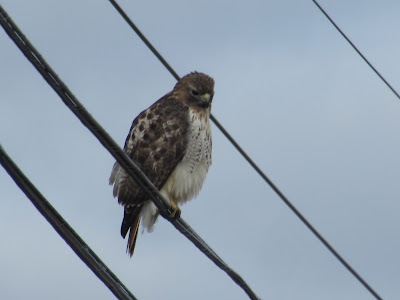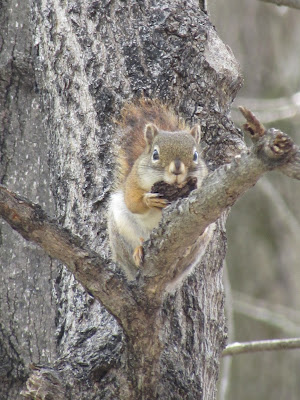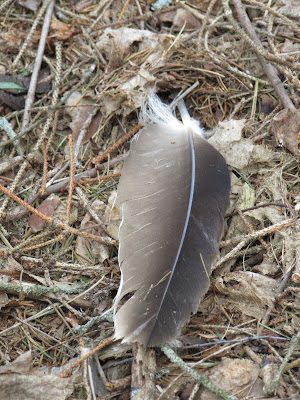Nature Note #165: Raptors In Our Midst
When most people see birds of prey, it's usually from a distance as they soar overhead or as we pass them on the highway, perched high on a branch waiting for their next meal. Since they are wild animals, generally they aren't too keen to stay close when they are suddenly encountered by a surprised human. A few seconds of acknowledged exchange before flushing off to the safety of the woods.
On those rare occasions where they will stay still enough for one to observe them up close, they watch us with those wild eyes that distrust anything that approaches too directly. A few years ago, I was lucky enough to photograph a young red-tailed hawk (Buteo jamaicensis) sitting on a telephone wire in Concord, Massachusetts. The bird eyed me warily as snapped some photos, but never moved. One could interpret it as stoic pride, but at risk of anthropomorphizing my subject, it seemed more likely that it didn't want to move from it's chosen hunting post.
On Sunday, Alison and I explored the huge park behind our new apartment. Marcellus Park is a beautiful countryside park with the usual amenities: two baseball diamonds, a raucous playground, and spacious lawns abutting the meandering Ninemile Creek that runs through town. Several men were fishing the stream and while I saw none of them catch a fish, I noticed some small trout swimming in the riffles as we walked over a small bridge towards the western edge of the park. Robins and cardinals sang cheerily in the trees while red squirrels (Tamiasciurus hudsonicus) scampered through the leaves of the nearby woods.
As we entered a vast stand of trees, Alison noticed a large brown feather resting on the trail. It looked like a goose feather based on the size, but it seemed different to me. For one thing, it was in the middle of the woods away from the river. For another, the river was too quick and shallow for it to be ideal for a family of geese.
"I don't think that's a goose feather. It might be a turkey vulture though.", I suggested.
"No way. It's got to be a goose.", Alison replied.
As we puzzled over the mystery, Alison looked into the woods and spotted another feather. And then another and another.
"Look over here!" She motioned for me to look closer. There were more feathers littering the ground in random spots. Short, broad ones as well as long thick ones lay helter skelter on the forest floor.
"Hey. What's that?" She pointed to the ground where a small hairball sat.
"Oh jackpot!", I cried. "With this pellet and the wash on the branches, it's definitely a vulture roost!"
"Wait...that's a pellet?", Alison inquired.
"Yep. Most raptors produce pellets.", I replied.
If you had ecologically minded teachers when you were in your school science class, you most likely have dissected owl pellets. They were probably small, dry, almost dusty with small, delicate bones of the owl's last victim encased in their hair. As you teased apart the pellet, you almost always found the skull of a mouse or rat towards the center of the pellet with an assortment of ribs, scapulars, and vertebrae scattered throughout.
This pellet was different from those I had dissected in school. It looked like a wiry dust bunny with a series of disparate bones scattered throughout the tangle. I had no idea what this bird had eaten, but it was certainly hairy.
As I had mentioned to Alison beforehand, predatory birds like eagles, hawks, owls, and vultures, will "cast" pellets after having consumed animal prey. Other birds that do so include cormorants, herons, gulls, terns, shrikes, and even crows. The purpose is to remove indigestible material from the bird's stomach and gizzard and typically occurs 10-16 hours after their last meal. Items such as bones, teeth, and occasionally exoskeletons and insect wings can be found inside them.
Vultures however, take this process a step further. It is important to keep in mind that not only do turkey vultures eat other animals, but more importantly that they are the vacuum cleaners of the skies. They hoover the dead from the earth with voracious eyes and noses that can scan for and detect the faintest scent of dead flesh on the air. While most birds have a poor sense of smell, turkey vultures can smell a potential meal from over a quarter of a mile away. In addition to their powerful senses, their immune systems are so robust that they can consume carcasses infected with anthrax, salmonella, and botulism without getting a stomach ache!
Most people are leery of vultures when they see them up close. It's probably their bald heads and gnarled beaks that make them seem even more gruesome then their already tarnished reputations. They aren't many people's favorite birds.
Within the past few years, I've made it my job to learn at least one appealing fact about misunderstood creatures like vultures. While my favorite fact centers around their fecal cooling methodology, I also have learned about their dedication that they have to their mates and their nesting sites, often returning to the same sheltered patch of ground year after year.
Without journeying off the trail, Alison and I would have never made this discovery about having these raptors in our midst. I'm pleased that we got the chance to see this roosting site. Hopefully, in the future we can see it in use. It has been three years since I've seen an active roost and it would be a pleasure to see these birds up close once again.
Edward Abbey once said of the turkey vulture:
On Sunday, Alison and I explored the huge park behind our new apartment. Marcellus Park is a beautiful countryside park with the usual amenities: two baseball diamonds, a raucous playground, and spacious lawns abutting the meandering Ninemile Creek that runs through town. Several men were fishing the stream and while I saw none of them catch a fish, I noticed some small trout swimming in the riffles as we walked over a small bridge towards the western edge of the park. Robins and cardinals sang cheerily in the trees while red squirrels (Tamiasciurus hudsonicus) scampered through the leaves of the nearby woods.
As we entered a vast stand of trees, Alison noticed a large brown feather resting on the trail. It looked like a goose feather based on the size, but it seemed different to me. For one thing, it was in the middle of the woods away from the river. For another, the river was too quick and shallow for it to be ideal for a family of geese.
"I don't think that's a goose feather. It might be a turkey vulture though.", I suggested.
"No way. It's got to be a goose.", Alison replied.
As we puzzled over the mystery, Alison looked into the woods and spotted another feather. And then another and another.
"Look over here!" She motioned for me to look closer. There were more feathers littering the ground in random spots. Short, broad ones as well as long thick ones lay helter skelter on the forest floor.
"Hey. What's that?" She pointed to the ground where a small hairball sat.
"Oh jackpot!", I cried. "With this pellet and the wash on the branches, it's definitely a vulture roost!"
"Wait...that's a pellet?", Alison inquired.
"Yep. Most raptors produce pellets.", I replied.
If you had ecologically minded teachers when you were in your school science class, you most likely have dissected owl pellets. They were probably small, dry, almost dusty with small, delicate bones of the owl's last victim encased in their hair. As you teased apart the pellet, you almost always found the skull of a mouse or rat towards the center of the pellet with an assortment of ribs, scapulars, and vertebrae scattered throughout.
This pellet was different from those I had dissected in school. It looked like a wiry dust bunny with a series of disparate bones scattered throughout the tangle. I had no idea what this bird had eaten, but it was certainly hairy.
As I had mentioned to Alison beforehand, predatory birds like eagles, hawks, owls, and vultures, will "cast" pellets after having consumed animal prey. Other birds that do so include cormorants, herons, gulls, terns, shrikes, and even crows. The purpose is to remove indigestible material from the bird's stomach and gizzard and typically occurs 10-16 hours after their last meal. Items such as bones, teeth, and occasionally exoskeletons and insect wings can be found inside them.
Vultures however, take this process a step further. It is important to keep in mind that not only do turkey vultures eat other animals, but more importantly that they are the vacuum cleaners of the skies. They hoover the dead from the earth with voracious eyes and noses that can scan for and detect the faintest scent of dead flesh on the air. While most birds have a poor sense of smell, turkey vultures can smell a potential meal from over a quarter of a mile away. In addition to their powerful senses, their immune systems are so robust that they can consume carcasses infected with anthrax, salmonella, and botulism without getting a stomach ache!
 |
| Turkey vultures at SBMWA offices in Pennington, NJ in March 2013 |
Within the past few years, I've made it my job to learn at least one appealing fact about misunderstood creatures like vultures. While my favorite fact centers around their fecal cooling methodology, I also have learned about their dedication that they have to their mates and their nesting sites, often returning to the same sheltered patch of ground year after year.
Without journeying off the trail, Alison and I would have never made this discovery about having these raptors in our midst. I'm pleased that we got the chance to see this roosting site. Hopefully, in the future we can see it in use. It has been three years since I've seen an active roost and it would be a pleasure to see these birds up close once again.
Edward Abbey once said of the turkey vulture:
"Let us praise the noble turkey vulture: No one envies him; he harms nobody; and he contemplates our little world from a most serene and noble height."
I can say firmly that I envy the vulture in one respect. Having the ability to soar over the world and look over our forested hills and farm fields and look at the world beyond would be a wonderful feeling. Until that day comes, we'll keep watching the skies for those noble turkey vultures as they drift upwards into the blue.








Excellent piece of writing.
ReplyDelete